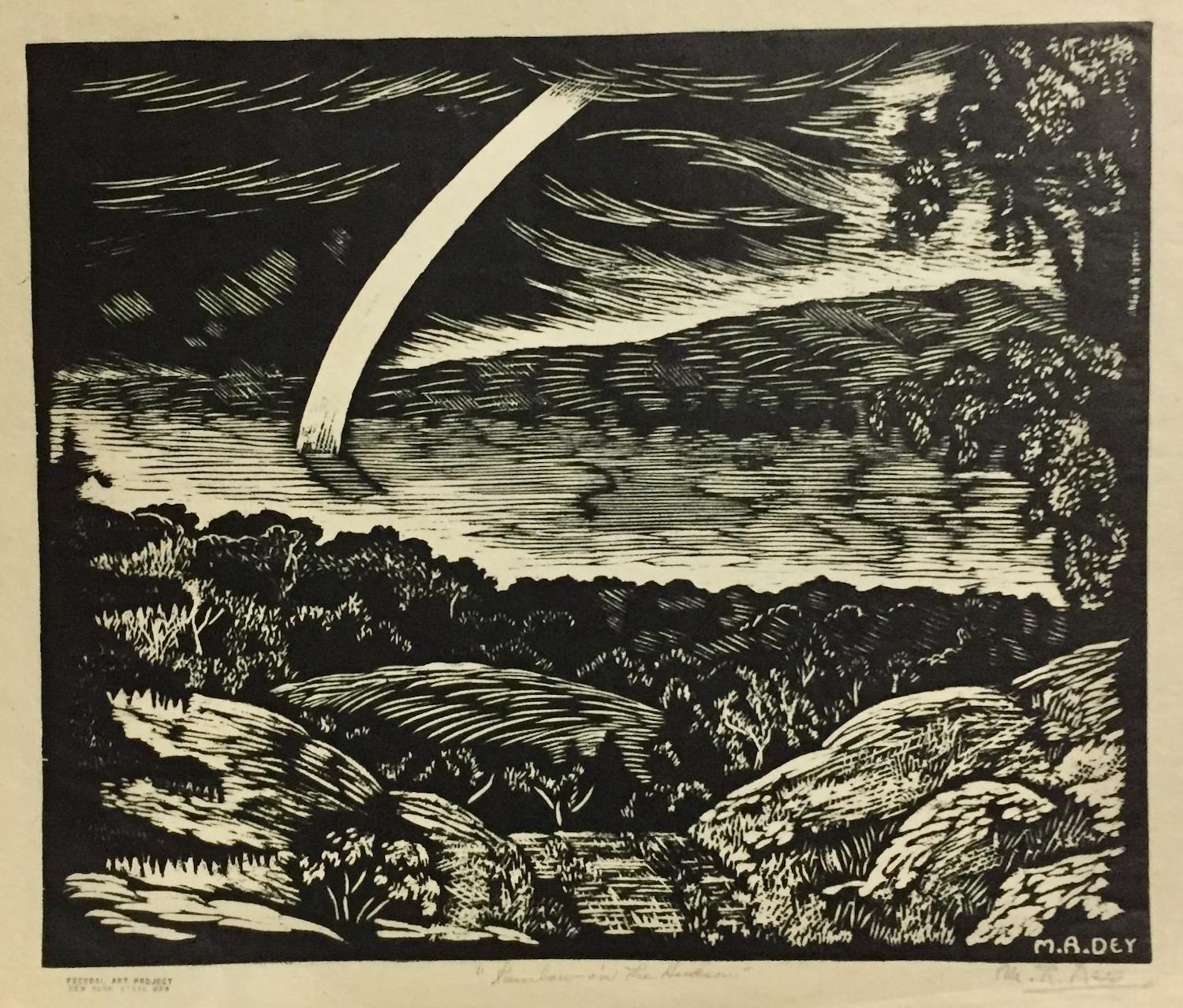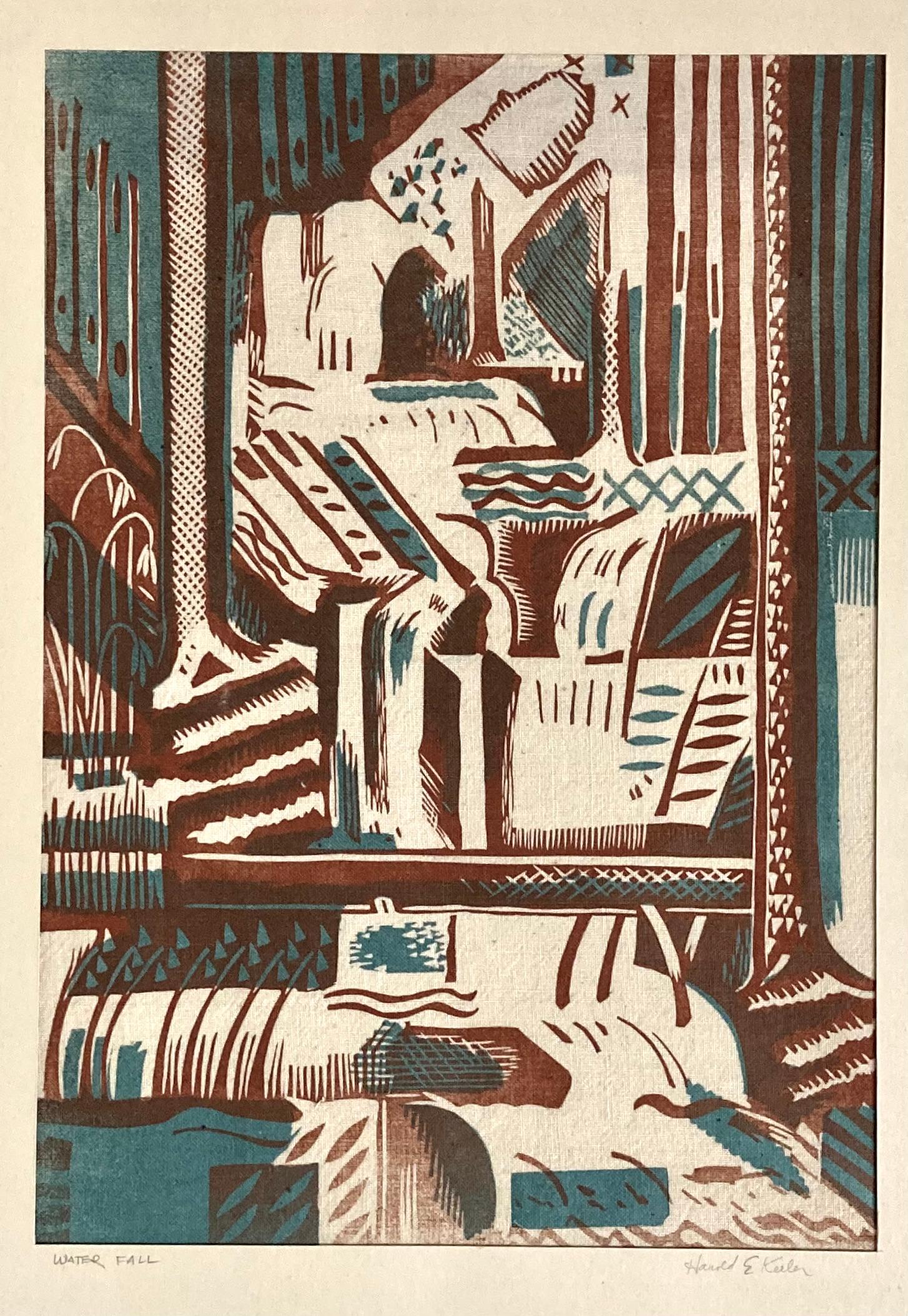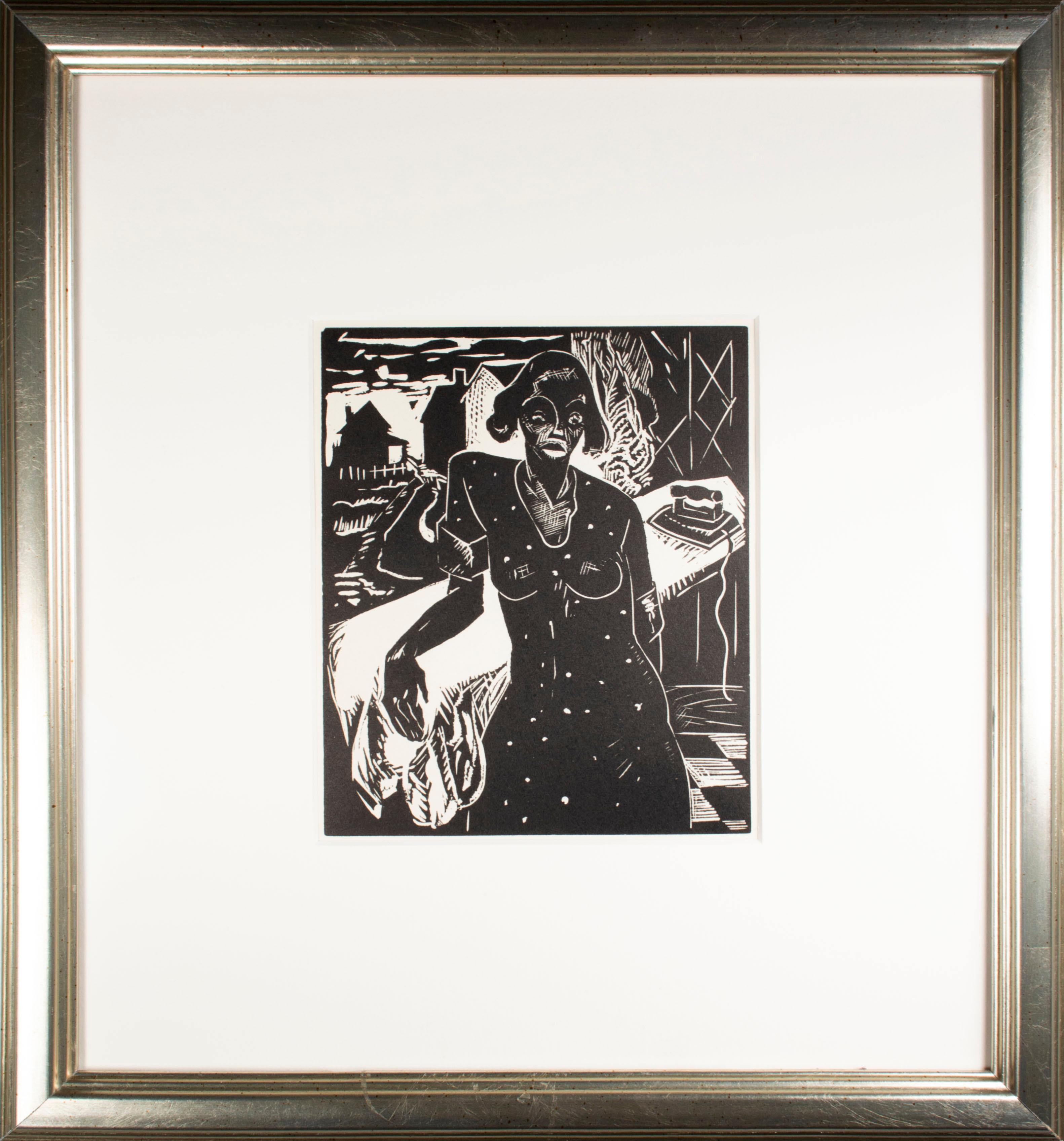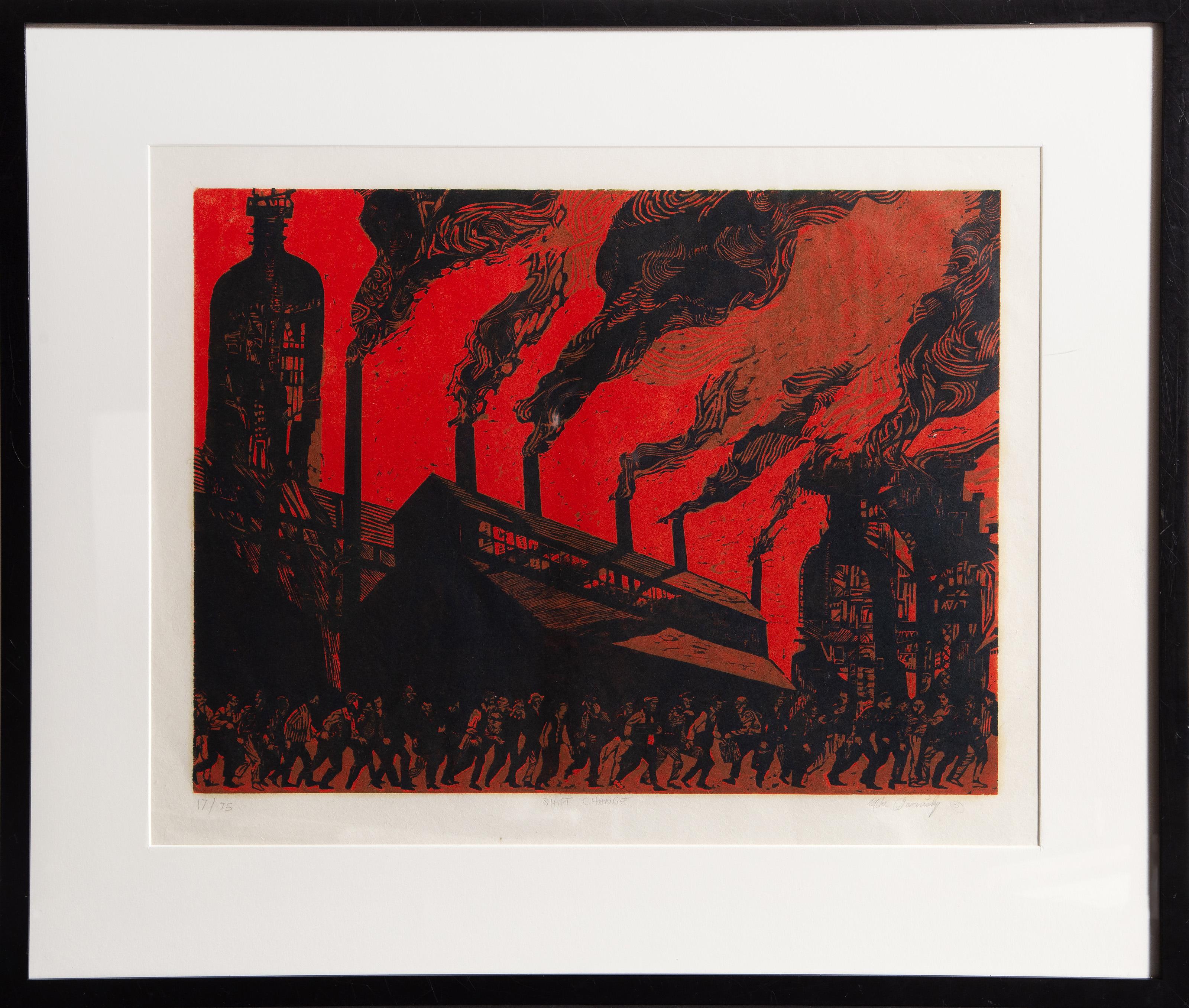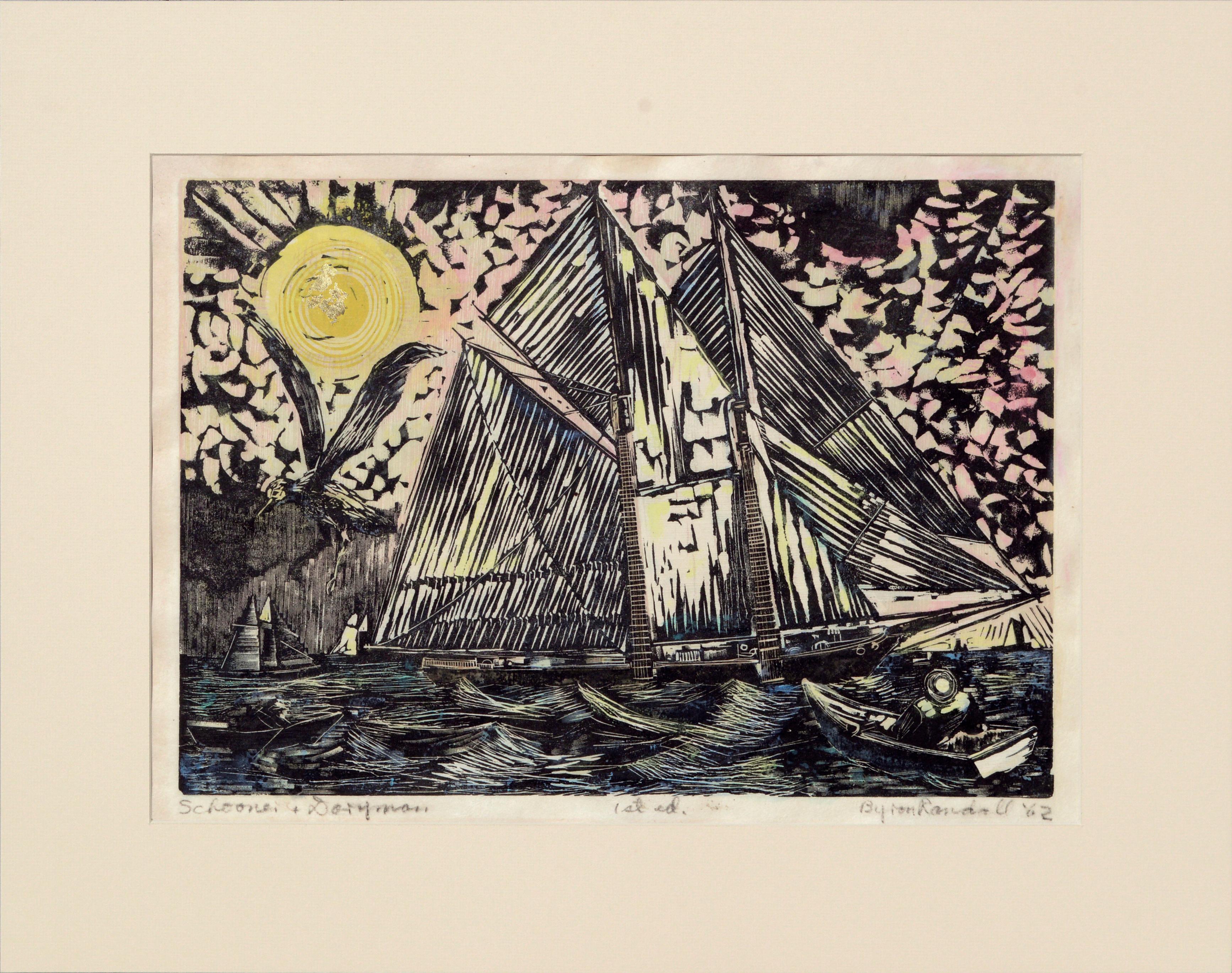Items Similar to Saturday Morning (Market, Taos Plaza, New Mexico), 1950s Figural Linocut Print
Video Loading
Want more images or videos?
Request additional images or videos from the seller
1 of 13
Barbara LathamSaturday Morning (Market, Taos Plaza, New Mexico), 1950s Figural Linocut Print
About the Item
1950s modernist linoleum cut print titled 'Saturday Morning (Market, Taos Plaza, New Mexico) by New Mexican artist Barbara Latham. Depicting a busy Saturday morning at the market in Taos Pueblo with horse and cart, Native American figures, adobe buildings and mountains in the background. Presented in a custom frame with all archival materials, outer dimensions measure 16 x 17 ¾ inches. Image size is 8 ½ x 10 ½ inches.
About the Artist:
Beginning her career as a commercial artist, Barbara Latham travelled to Taos in 1925 seeking material for a greeting card. Serendipitously, she also found her life partner, Howard Cook, who was similarly looking for ideas for illustrations. Perhaps both were fueled in their quest by the tales of their mutual teacher, Andrew Dasburg, who knew of the energy and stimulation of this artist community. Observing local people and customs, Latham created genre scenes that offer a window into this now-vanished time and place. Her lively illustrations for numerous children's books are a significant contribution to that graphic art in the mid-20th century.
Born in Walpole, Massachusetts, Latham's student days included Norwich Art School and Pratt Institute in Brooklyn; but it was contact with the charismatic Dasburg at the Art Students League in Woodstock that opened her world and her view of art. Getting work with companies like Norcross Publishing and Forum magazine, she eventually made her way to Taos. Among all the spirited young artists gathered there, she met Howard Cook, who was designing illustrations for Willa Cather's Death Comes to the Archbishop. The two married in Santa Fe and began a nomadic life together.
The young couple made their way to Paris, a likely destination for modernist artists. Upon receiving a Guggenheim to study fresco painting in 1932, Cook, along with Latham, took an alternative direction and headed to Taxco, Mexico. At this time, Mexican muralists, such as Diego Rivera, were capturing the attention of progressive artists. During the Depression, both Cook and Latham aligned themselves with a populist ideal. Latham contributed work, such as "Fording the Stream" and "Bear Family," to the American Artists Group, which was founded to produce original prints at affordable prices. The couple also travelled in the Deep South to the Ozarks and to "Alabama's Black Belt."
When Latham settled in Taos, she was committed to an art of and for the people. Rather than a romanticized re-creation, her choice of subjects was based in common everyday activities, favoring those which brought people together. Taos Pueblo was an ancient, indigenous community, and Latham's view extended that tradition into a contemporary, multi-ethnic village. Sharing some of the spirit of WPA photographs, these works deviated from documentary in the bravado of brushstroke and pulsating compositions. Providing a livelihood, Latham's illustrations for children's books reflected her heartfelt belief in the availability of art for all, and her style of open brushwork contributed to a modernist transformation of this graphic art.
After World War II, Latham experimented with Surrealism and abstraction. Many of her painted genre scenes of the fifties simplify forms in order to intensify the interplay of color and shapes. With minimal background, figures are elegantly drawn to an essence, which seems to both capture their actions and take them out of time. Riders on horses have the same linear classicism of Parthenon sculptures, and the brilliance of figure groupings separate them from the background like a frieze. Latham selects pure pigments that lend a lively rhythm, creating a pleasing balance of stasis of vigorous movement.
Latham and Cook had a long-lived marriage, which was grounded in keeping their creative life separate. Latham even confessed that she did not recognize some of her husband's work upon exhibition. In 1976, the couple moved to Santa Fe, which became their final home.
- Creator:Barbara Latham (1896 - 1989, American)
- Dimensions:Height: 16 in (40.64 cm)Width: 17.75 in (45.09 cm)
- Medium:
- Movement & Style:
- Period:
- Condition:very good to excellent vintage condition. Custom frame has recently been added.
- Gallery Location:Denver, CO
- Reference Number:
About the Seller
5.0
Platinum Seller
These expertly vetted sellers are 1stDibs' most experienced sellers and are rated highest by our customers.
Established in 1979
1stDibs seller since 2013
267 sales on 1stDibs
Typical response time: 1 hour
- ShippingRetrieving quote...Ships From: Denver, CO
- Return PolicyA return for this item may be initiated within 7 days of delivery.
More From This SellerView All
- 'Mining Town' , American Modern Signed Lithograph, Colorado Mining Town SceneBy Robert BeauchampLocated in Denver, COAmerican modern lithograph on paper titled 'Mining Town' signed by artist Robert Beauchamp (1923-1995) featuring a figure walking and a cat sitting on a fence in a mining town. Image...Category
Mid-20th Century American Modern Landscape Prints
MaterialsPaper, Lithograph
- Gateside Conversation, 1940s Original Signed Lithograph by Thomas Hart BentonBy Thomas Hart BentonLocated in Denver, CO'Gateside Conversation' is an original signed lithograph by Thomas Hart Benton (1889-1975) from 1946. Singed by the artist in the lower right margin and titled verso. Portrays a figu...Category
1940s American Modern Figurative Prints
MaterialsPaper, Lithograph
- Grand Lake, Yacht Races, Colorado Mountain Lake, 1930s Black White PrintBy Arnold RönnebeckLocated in Denver, COGrand Lake, Colorado, Yacht Races, vintage 1930s modernist, WPA era black and white lithograph by Colorado artist, Arnold Ronnebeck (1885-1947). Lake with ...Category
1930s American Modern Landscape Prints
MaterialsLithograph
- Silver Mine, Russell Gulch (12/25) Abstract Black and White Print in MountainsBy Arnold RönnebeckLocated in Denver, COLithograph on paper titled 'Silver Mine, Russell Gulch (12/25)' by Arnold Ronnebeck, which is a black and white lithograph print of an oil painting by him of the same name. It shows a mine with a mountain ridge in the background. Presented in a custom frame measuring 20 ½ x 26 ½ inches. Image size measures 10 ¼ x 14 ¼ inches. Print is clean and in very good vintage condition - please contact us for a detailed condition report. Provenance: Estate of Arnold Ronnebeck Expedited and international shipping is available - please contact us for a quote. About the Artist: Modernist sculptor, lithographer and museum administrator, Rönnebeck was a noted member of European and American avant-garde circles in the early twentieth century before settling in Denver, Colorado, in 1926. After studying architecture at the Royal Art School in Berlin for two years beginning in 1905, he moved to Paris in 1908 to study sculpture with Aristide Maillol and Émile-Antoine Bourdelle. While there he met and befriended American modernist painter, Marsden Hartley, of whom he sculpted a bronze head that was exhibited at the Salon d’Automne in Paris in 1912 and the following year at Hartley’s solo show of paintings at Alfred Stieglitz’s Gallery 291 in New York. A frequent guest of Gertrude Stein’s Saturday "evenings" in Paris, she described Rönnebeck as "charming and always invited to dinner," along with Pablo Picasso, Mabel Dodge (Luhan) and Charles Demuth. After the outbreak of World War I in 1914, Rönnebeck returned to Germany where he served as an officer in the German Imperial Army on the front lines. Twice wounded, including in the Battle of Marne in France, Kaiser Wilhelm II awarded him the Iron Cross. During the war Hartley fell in love with Rönnebeck’s cousin, Lieutenant Karl von Freyburg, who was killed in combat. As a tribute to Freyburg, Hartley created Portrait of a German Officer (1914) now in the Metropolitan Museum of Art in New York. After the war Rönnebeck traveled in Italy with German writer, Max Sidow, and German poet, Theodor Daubler, doing a series of drawings of Positano and the Amalfi Coast that formed the basis for his lithographs on the subject. The death of his finacée, the young American opera singer Alice Miriam in 1922 and his own family’s increasing financial problems in post-World War I Germany led him to immigrate to the United States in 1923. After living briefly with Miriam’s family in Washington, DC, he moved to New York where he became part of the avant-garde circle around Alfred Stieglitz. His essay, "Through the Eyes of a European Sculptor," appeared in the catalog for the Anderson Gallery exhibition, "Alfred Stieglitz Presents Seven Americans: 159 Paintings, Photographs & Things, Recent & Never Publicly Shown, by Arthur G. Dove, Marsden Hartley, John Marin, Charles Demuth, Paul Strand, Georgia O’Keeffe, Alfred Stieglitz." In New York Rönnebeck began producing Precisionist-style lithographs of the city’s urban landscapes which he termed "living cubism." Some of them were reproduced in Vanity Fair magazine. Through Stieglitz he met Erhard Weyhe head of the Weyhe Gallery who, with its director Carl Zigrosser, arranged Rönnebeck’s first solo American exhibition in May 1925 at the gallery in New York. Comprising some sixty works – prints, drawings and sculpture – the show subsequently traveled on a thirteen-month tour of major American cities. Until the end of his life, the gallery represented him, along with other American artists Adolf Dehn, Wanda Gag, Rockwell Kent, J.J. Lankes, Louis Lozowick, Reginald Marsh and John Sloan. In the summer of 1925, as the guest of Mabel Dodge Luhan, Rönnebeck first saw Taos, New Mexico, which Marsden Hartley had encouraged him to visit. It was there that he met his future wife, Louise Emerson, an easel painter and muralist. A year later they were married in New York before relocating to Denver. He served as director of the Denver Art Museum from 1926 to 1930 where he invited Marsden Hartley to lecture on Cézanne’s art in 1928. Rönnebeck fostered the development of the museum’s collection of American Indian art and the curation of modernist art exhibitions. In addition to his work at the museum, he was professor of sculpture at the University of Denver’s College of Fine and Applied Arts from 1929 to 1935, and wrote a weekly art column in the Rocky Mountain News. His best known Denver sculptures from the late 1920s in bronze, copper, stone, wood and terra cotta include a reredos, The Epiphany, at St. Martin’s Chapel; The History of Money (six panels) at the Denver National Bank; The Ascension at the Church of Ascension; and the William V. Hodges Family Memorial at Fairmount Cemetery. At the same time he did a series of terra cotta relief panels for La Fonda Hotel in Santa Fe, New Mexico. In the 1930s his bas-relief aluminum friezes of stylized Pueblo and Hopi Indian Kachina masks...Category
1930s American Modern Figurative Prints
MaterialsPaper, Lithograph
- Mine Near Continental Divide, Black White Colorado Mountain Landscape WinterBy Arnold RönnebeckLocated in Denver, COLithograph on paper titled 'Mine Near Continental Divide' by Arnold Ronnebeck (1885-1947) from 1933. Depicts a black and white winter scene of a mine in the mountains with snow on the rooftops and hillsides. Presented in a custom frame measuring 18 ¼ x 22 ¼ inches. Image size measures 10 ¼ x 14 ½ inches. Provenance: Estate of the Artist, Arnold Ronnebeck Expedited and international shipping is available - please contact us for a quote. About the Artist: Modernist sculptor, lithographer and museum administrator, Rönnebeck was a noted member of European and American avant-garde circles in the early twentieth century before settling in Denver, Colorado, in 1926. After studying architecture at the Royal Art School in Berlin for two years beginning in 1905, he moved to Paris in 1908 to study sculpture with Aristide Maillol and Émile-Antoine Bourdelle. While there he met and befriended American modernist painter, Marsden Hartley, of whom he sculpted a bronze head that was exhibited at the Salon d’Automne in Paris in 1912 and the following year at Hartley’s solo show of paintings at Alfred Stieglitz’s Gallery 291 in New York. A frequent guest of Gertrude Stein’s Saturday "evenings" in Paris, she described Rönnebeck as "charming and always invited to dinner," along with Pablo Picasso, Mabel Dodge (Luhan) and Charles Demuth. After the outbreak of World War I in 1914, Rönnebeck returned to Germany where he served as an officer in the German Imperial Army on the front lines. Twice wounded, including in the Battle of Marne in France, Kaiser Wilhelm II awarded him the Iron Cross. During the war Hartley fell in love with Rönnebeck’s cousin, Lieutenant Karl von Freyburg, who was killed in combat. As a tribute to Freyburg, Hartley created Portrait of a German Officer (1914) now in the Metropolitan Museum of Art in New York. After the war Rönnebeck traveled in Italy with German writer, Max Sidow, and German poet, Theodor Daubler, doing a series of drawings of Positano and the Amalfi Coast that formed the basis for his lithographs on the subject. The death of his finacée, the young American opera singer Alice Miriam in 1922 and his own family’s increasing financial problems in post-World War I Germany led him to immigrate to the United States in 1923. After living briefly with Miriam’s family in Washington, DC, he moved to New York where he became part of the avant-garde circle around Alfred Stieglitz. His essay, "Through the Eyes of a European Sculptor," appeared in the catalog for the Anderson Gallery exhibition, "Alfred Stieglitz Presents Seven Americans: 159 Paintings, Photographs & Things, Recent & Never Publicly Shown, by Arthur G. Dove, Marsden Hartley, John Marin, Charles Demuth, Paul Strand, Georgia O’Keeffe, Alfred Stieglitz." In New York Rönnebeck began producing Precisionist-style lithographs of the city’s urban landscapes which he termed "living cubism." Some of them were reproduced in Vanity Fair magazine. Through Stieglitz he met Erhard Weyhe head of the Weyhe Gallery who, with its director Carl Zigrosser, arranged Rönnebeck’s first solo American exhibition in May 1925 at the gallery in New York. Comprising some sixty works – prints, drawings and sculpture – the show subsequently traveled on a thirteen-month tour of major American cities. Until the end of his life, the gallery represented him, along with other American artists Adolf Dehn, Wanda Gag, Rockwell Kent, J.J. Lankes, Louis Lozowick, Reginald Marsh and John Sloan. In the summer of 1925, as the guest of Mabel Dodge Luhan, Rönnebeck first saw Taos, New Mexico, which Marsden Hartley had encouraged him to visit. It was there that he met his future wife, Louise Emerson, an easel painter and muralist. A year later they were married in New York before relocating to Denver. He served as director of the Denver Art Museum from 1926 to 1930 where he invited Marsden Hartley to lecture on Cézanne’s art in 1928. Rönnebeck fostered the development of the museum’s collection of American Indian art and the curation of modernist art exhibitions. In addition to his work at the museum, he was professor of sculpture at the University of Denver’s College of Fine and Applied Arts from 1929 to 1935, and wrote a weekly art column in the Rocky Mountain News. His best known Denver sculptures from the late 1920s in bronze, copper, stone, wood and terra cotta include a reredos, The Epiphany, at St. Martin’s Chapel; The History of Money (six panels) at the Denver National Bank; The Ascension at the Church of Ascension; and the William V. Hodges Family Memorial at Fairmount Cemetery. At the same time he did a series of terra cotta relief panels for La Fonda Hotel in Santa Fe, New Mexico. In the 1930s his bas-relief aluminum friezes of stylized Pueblo and Hopi Indian Kachina masks...Category
1930s American Modern Landscape Prints
MaterialsLithograph, Paper
- Comanche Dance, Ildefonso Pueblo, New Mexico Southwest Framed EtchingBy Gene KlossLocated in Denver, COComanche Dance at San Ildefonso Pueblo (New Mexico). Etching and drypoint, artist's proof from an edition of 50 prints. Presented in a custom frame, outer dimensions measure 22 ¼ x 18 ½ x ½ inches. Image size is 11 ¾ x 14 ½ inches. Print is clean and in very good vintage condition - please contact us for a detailed condition report. Expedited and international shipping is available - please contact us for a quote. About the Artist: Gene (Alice Geneva) Kloss is considered one of America’s master printmakers. She was born in Oakland, California and established herself as an artist on the West coast. Kloss was introduced to etching by Perham Nahl while at UC Berkley. She graduated in 1924, and in 1925 married poet Phillips Kloss. In her late twenties, Kloss moved to Taos, New Mexico and began her life’s work of the New Mexican landscape and peoples. It was at this time that she received national acclaim. Her artwork exudes an unmistakable content and style. Enchanted by the architecture, mountainous landscapes and rituals of the inhabitants, Kloss captured the beauty of the Southwest and surrounding areas. Her style was bold yet deftly simple, masterfully expressing the elusive Southwestern light...Category
1980s American Modern Figurative Prints
MaterialsDrypoint, Etching
You May Also Like
- Maurice Robert Dey, Rainbow on the HudsonLocated in New York, NYBiographical information on Maurice Robert Dey is hard to find. He was born on 1899 (or maybe 1900), in Switzerland. As an adult he lived and worked in Woodstock, the NY artists' c...Category
1930s American Modern Landscape Prints
MaterialsLinocut
- Evelyn G. Schultz, TyphoonLocated in New York, NYThe only mention I can find of Evelyn G. Schultz is that she was a charter member of the San Diego Watercolor Society. But the medium of the linocut (here on tan paper) was frequentl...Category
1940s American Modern Figurative Prints
MaterialsLinocut
- Harold E. Keeler, Water FallLocated in New York, NYHarold E. Keeler worked in Hollywood as a set designer. That seems especially important here because the Water Fall looks a little as though it could be a woodland stage set -- to me...Category
1930s American Modern Landscape Prints
MaterialsLinocut
- 'Monday in Wick Haven' original linoleum cut print by Howard ThomasBy Howard ThomasLocated in Milwaukee, WIIn this image, Howard Thomas presents the viewer with a domestic interior. The image is dominated by the figure of a black woman, resting her arm on an ironing board. To the right, the tool of her task dangles a chord above a checker tiled floor. Beyond, though a window, neighboring homes fill the landscape. The careful line-work of the linocut adds a sense of expressionism to the scene, but the image nonetheless falls into the Social Realism that captivated most American artists during the Great Depression. This print was published in 1936 as part of the Wisconsin Artists' Calendar for the year 1937, which included 52 original, hand-made prints – one for each week of the year. 6 x 5 inches, image 10 x 7.13 inches, sheet 12.37 x 12.43 inches, frame Entitled "Monday in Wick Haven" lower left (covered by matting) Inscribed "Linoleum Cut" lower center (covered by matting) Artist name "Howard Thomas" lower right (covered by matting) Framed to conservation standards using 100 percent rag matting and museum glass, all housed in a silver gilded moulding. Quaker-born in Ohio, Thomas trained in the Midwest at Ohio State University and the Chicago Art Institute. He taught in the Art Department of the Milwaukee State Teachers College (now University of Wisconsin-Milwaukee) where he became good friends with Carl Holty, Edward Boerner, Robert von Neumann...Category
1930s American Modern Figurative Prints
MaterialsLinocut, Engraving
- Shift Change, Social Realist Woodblock Print by Mike GoscinskyLocated in Long Island City, NYShift Change Mike Goscinsky, American (1933–2021) Woodblock on thin wove paper, signed, titled and numbered in pencil Edition of 15/75 Image Size: 14 x 19 inches Size: 22 x 26.5 in. ...Category
1990s American Modern Landscape Prints
MaterialsWoodcut
- "Schooner + Doryman" First Edition Hand-Colored Woodblock PrintBy Byron RandallLocated in Soquel, CABold woodblock print by Byron Randall (American, 1918-1999). Titled "Schooner + Doryman", numbered "1st ed.", and signed and dated "Byron Randall '62" along the bottom edge. Small am...Category
1960s American Modern Landscape Prints
MaterialsGold Leaf
Recently Viewed
View AllMore Ways To Browse
Market Place
1950s New Look
Mexican Children
Plaza On
Horse Head Prints
1950s Vintage Belts 1950s Belts
Village People Midcentury
Framed Wpa Prints
Modern Horse Sculpture Head
Linoleum Cut
Life Size Horse Heads
Horse Fording
Pueblo Black
Modernist Taxco
Saturday Morning
Horse Belt
Original Native American Paintings Horse
Vintage Latham
